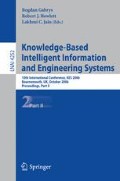Abstract
Context-aware computing that recognizes the context in which a user performs a task is one of the most important techniques for supporting user activity in ubiquitous computing. To realize context-aware computing, a computer needs to recognize the user’s location. This paper describes a technique for location detection inside a room using radio waves from a user’s computer. The proposed technique has to be sufficiently robust to cater for dynamic environments and should require only ordinary network devices, such as radio signal emitters, without the need for special equipment. We propose performing localization by relative values of RSSI (Received Signal Strength Indicator) among wireless nodes. Furthermore, we use SVM (Support Vector Machine) to find the criteria for classification (whether a node is inside or outside a given area), in the case where absolute RSSI values are used for localization.
Access this chapter
Tax calculation will be finalised at checkout
Purchases are for personal use only
Preview
Unable to display preview. Download preview PDF.
References
Schilit, B., Adams, N., Want, R.: Context-Aware Computing Applications. In: IEEE Workshop on Mobile Computing Systems and Applications, Santa Cruz, CA, US (1994)
Harter, A., Hopper, A., Steggles, P., Ward, A., Webster, P.: The Anatomy of a Context-Aware Application. In: Proceedings of the Fifth Annual ACM/IEEE International Conference on Mobile Computing and Networking (MobiCom 1999), Seattle, Washington, USA, August 1999, pp. 59–68 (1999)
Priyantha, N.B., Chakraborty, A., Balakrishnan, H.: The Cricket location-support system. In: The 6th Annual ACM/IEEE International Conference on Mobile Computing and Networking (MobiCom 2000), Boston, MA, USA, August 2000, pp. 32–43 (2000)
Iwaya, A., Nishio, N., Murase, M., Tokuda, H.: GOMASHIO: Proximity Based Localization In Wireless Ad-Hoc Sensor Networks. IPSJ SIG Mobile Computing and Ubiquitous Networking 108, 23–30 (2001) (in Japanese)
Kitasuka, T., Nakanishi, T., Fukuda, A.: Wireless LAN based Indoor Positioning System WiPS and Its Simulation. In: IEEE Pacific Rim Conference on Com-munications, Computers and Signal Processing (PACRIM 2003), August 2003, pp. 272–275 (2003)
Bulusu, N., Heidemann, J., Estrin, D.: GPS-less Low Cost Outdoor Localization for Very Small Devices. IEEE Personal Communications Magazine 7(5), 28–34 (2000)
Ganesan, D., Estrin, D., Woo, A., Culler, D.: Complex Behavior at Scale: An Experimental Study of Low-Power Wireless Sensor Networks, Technical Report UCLA/CSD-TR 02-0013 (2002)
Ogawa, T., Yoshino, S., Shimizu, M.: The In-door Location Determination Method Using Learning Algorithms with Wireless Active Tags. IPSJ Ubiquitous Computing Systems (UBI) 2004(66), 31–38 (2004) (in Japanese)
He, T., Huang, C., Blum, B.M., Stankovic, J.A., Abdelzaher, T.F.: Range-Free Localization Schemes in Large Scale Sensor Networks. In: The Ninth Annual International Conference on Mobile Computing and Networking (MobiCom 2003), San Diego, CA (September 2003)
Brumitt, B., Shafer, S.: Topological World Modeling Using Semantic Spaces. In: Workshop Proceedings, UbiComp 2001, pp. 55–62 (2001)
Vapnik, V.: Statistical learning theory. John Wiley & Sons, New York (1998)
Sakamoto, J., Miura, H., Matsuda, N., Taki, H., Abe, N., Hori, S.: Indoor Location Determination Using a Topological Model. In: Khosla, R., Howlett, R.J., Jain, L.C. (eds.) KES 2005. LNCS (LNAI), vol. 3684, pp. 143–149. Springer, Heidelberg (2005)
Author information
Authors and Affiliations
Editor information
Editors and Affiliations
Rights and permissions
Copyright information
© 2006 Springer-Verlag Berlin Heidelberg
About this paper
Cite this paper
Miura, H., Sakamoto, J., Matsuda, N., Taki, H., Abe, N., Hori, S. (2006). Adequate RSSI Determination Method by Making Use of SVM for Indoor Localization. In: Gabrys, B., Howlett, R.J., Jain, L.C. (eds) Knowledge-Based Intelligent Information and Engineering Systems. KES 2006. Lecture Notes in Computer Science(), vol 4252. Springer, Berlin, Heidelberg. https://doi.org/10.1007/11893004_81
Download citation
DOI: https://doi.org/10.1007/11893004_81
Publisher Name: Springer, Berlin, Heidelberg
Print ISBN: 978-3-540-46537-9
Online ISBN: 978-3-540-46539-3
eBook Packages: Computer ScienceComputer Science (R0)

